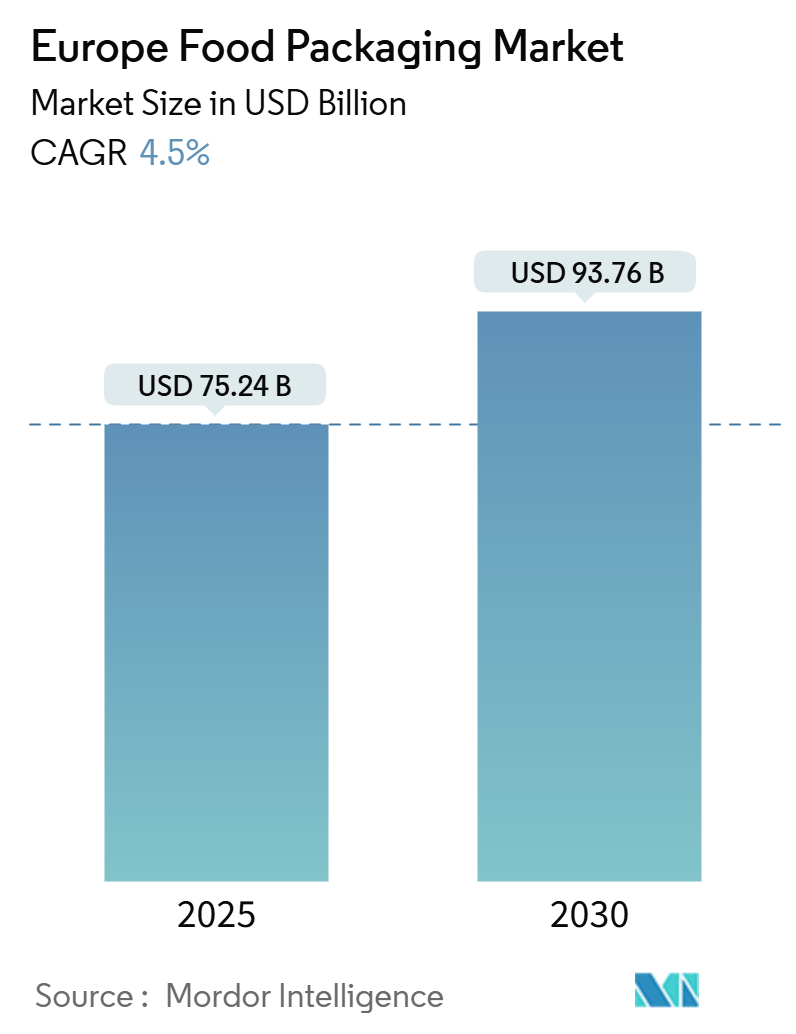
| Study Period | 2019 - 2030 |
| Base Year For Estimation | 2024 |
| Forecast Data Period | 2025 - 2030 |
| Market Size (2025) | USD 75.24 Billion |
| Market Size (2030) | USD 93.76 Billion |
| CAGR (2025 - 2030) | 4.50 % |
| Market Concentration | Low |
Major Players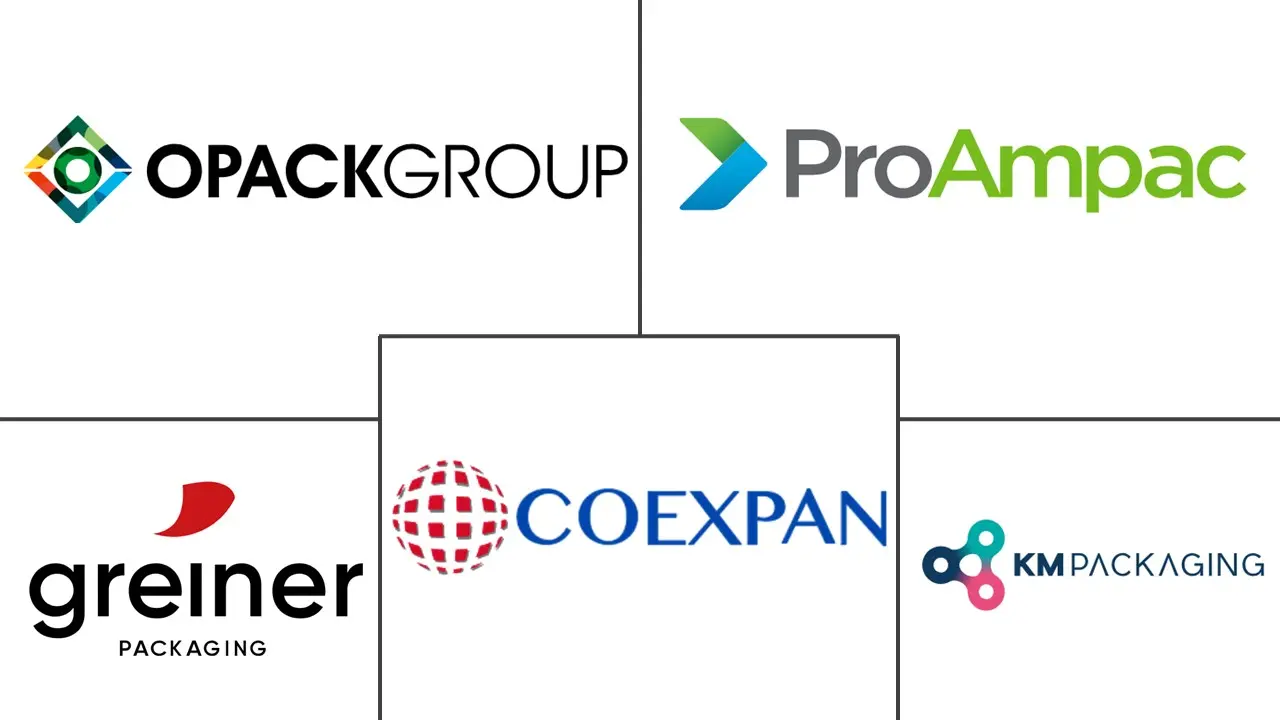
*Disclaimer: Major Players sorted in no particular order |
Europe Food Packaging Market Analysis
The Europe Food Packaging Market size is estimated at USD 75.24 billion in 2025, and is expected to reach USD 93.76 billion by 2030, at a CAGR of 4.5% during the forecast period (2025-2030).
- Packaging has evolved into a crucial component of everyday life. Its main function is to safeguard food items from external factors and potential harm while maintaining their freshness and flavor. Effective food packaging plays a vital role in preventing spoilage, preserving the advantages of processing, extending shelf life, and enhancing the quality and safety of food products. Innovations in food packaging have a profound influence on various aspects, including food logistics and preservation.
- Food packaging offers several essential advantages, including the mitigation of food contamination, the extension of food shelf-life, and enhanced operational efficiency. As urbanization continues to rise, there is an increasing demand for environmentally friendly packaging solutions and heightened consumer safety considerations, which are expected to drive market growth. Additionally, European nations have experienced robust demand for fresh fruits and vegetables, attributed to a shift toward organic options and the development of packaging that improves shelf life.
- The demand for sustainable packaging solutions across the region's food industry driven by government regulations is expected to drive innovations. In April 2024, the European Parliament approved new initiatives aimed at enhancing the sustainability of packaging and minimizing packaging waste across the European Union. The regulations, which received provisional agreement from the Council, established targets for packaging reduction of 5% by 2030, 10% by 2035, and 15% by 2040. Additionally, EU member states are mandated to specifically decrease the volume of plastic packaging waste. Starting from January 1, 2030, certain types of single-use plastic packaging will be prohibited, including packaging for unprocessed fresh fruits and vegetables, as well as packaging for food and beverages.
- The expansion of fresh food production, coupled with supportive government regulations, enhances the development of the fresh fruits and vegetables industry, subsequently propelling the growth of food packaging in the region. As reported by the CBI Ministry of Foreign Affairs, Europe represents a significant and stable market for a majority of fresh fruits and vegetables. The continuous demand for year-round availability and a diverse selection of produce sustains Europe's reliance on external suppliers. Annually, Europe imports approximately 55 million tonnes of fresh fruits and vegetables. Such factors are expected to drive the demand for suitable packaging solutions.
- The European Environmental Bureau reported that paper-based packaging constitutes the predominant source of packaging waste within the European Union. Furthermore, there is a growing trend in the use of paper-based materials for packaging food and beverages. The food and beverage industry accounts for over two-thirds of the overall packaging market in Europe. The European Parliament and the Council of the EU are evaluating a proposal from the European Commission for a new Packaging and Packaging Waste Regulation (PPWR), which aims to foster various innovations in the market.
- As consumers grow more aware of the significance of a balanced, plant-based diet, the demand for innovative packaging that enhances the shelf life and preserves the quality of fresh produce is increasing. In recent years, investment in European food start-ups has seen a substantial rise. The emergence of home delivery services across Europe considerably affected the food packaging market. The leading countries in Europe regarding platform-to-consumer revenue include the United Kingdom, Germany, France, Spain, and Italy, and this dominance is anticipated to stimulate the need for appropriate packaging solutions.
- Several vendors are also investing significantly to drive the packaging industry's capabilities in the region's food industry. In May 2024, twelve organizations within the European Union were awarded funding to investigate coatings for food packaging that do not contain PFAS. The ZeroF project is receiving co-funding from the Horizon Europe research investment program as well as from the Swiss State Secretariat for Education, Research and Innovation. Commonly referred to as "forever chemicals," PFAS are frequently utilized in coatings that enhance the resistance of food packaging to grease and moisture. Additionally, the rising investments aimed at enhancing food production capabilities across various countries in the region are anticipated to boost market growth.
- The volatility of raw material prices has the potential to hinder market expansion. As reported by European Plastics Converters, the European polymer market faced significant challenges for several months, with the adverse effects of raw material shortages and rising prices severely impacting the production of plastic products within the European Union. Moreover, the market is currently facing significant uncertainties regarding energy, largely attributable to the conflicts between Russia and Ukraine. These circumstances are leading to fluctuations in the supply and pricing of raw materials, as well as disruptions in transportation and logistics, which are exerting pressure on the profit margins of paper packaging manufacturers.
Europe Food Packaging Market Trends
The Foodservice Industry is Growing Rapidly
- The expansion of urban areas, evolving dietary preferences resulting from limited leisure time, and rising disposable incomes are key factors propelling the growth of the foodservice industry, thereby increasing the demand for food packaging solutions. Additionally, there has been a notable shift toward online food deliveries and take-out services, further amplifying the need for diverse food packaging products. Furthermore, numerous companies are actively strengthening their market presence through product launches.
- Snack foods have increasingly become a substitute for traditional meals, leading to a rise in the snack food market across European nations, primarily due to their convenience and rapid provision of nutrition and energy. According to the Glanbia Nutritionals report published in May 2024, savory snacks represented the leading subcategory in Europe, with 57% of consumers having made purchases in the previous year. This remarkable growth is poised to create substantial opportunities for packaging suppliers.
- Similarly, the increasing demand for other food products is driving investments in the region, which is expected to enhance the market's growth significantly. The European Commission forecasts that the domestic market will continue to be the main destination for EU milk production, representing 88% by 2035. There is a noticeable shift in consumer preferences, particularly among younger individuals who are increasingly favoring dairy products that have lower fat and sugar levels, as well as those designed for individuals with food intolerances. The health requirements of the aging population and changing lifestyle choices are expected to enhance demand for plant-based alternatives.
- In August 2023, a study conducted by the University of Hohenheim in Germany aimed to identify the determinants and drivers influencing the demand for plant-based dairy products across various EU countries with initially differing sales levels. Among the six countries examined, Germany had the highest sales and the greatest market potential for plant-based dairy products. Furthermore, the Good Food Institute reported that sales of dairy alternatives in Europe increased by over 45% from 2020 to 2023. These substantial factors are anticipated to drive market opportunities.
- Increasing investments by the major vendors to drive the foodservice industry across various countries, like Germany, France, and the United Kingdom, is further expected to drive the market's growth. As reported by GTIA, Germany's food and beverage industry remains a focal point for new investments from global investors eager to enter a market characterized by its diversity and profitability. The rise in individuals adopting vegetarian and vegan diets is contributing to the swift growth of the plant-based food industry in Germany. International firms, such as Switzerland's Planted, are capitalizing on this trend. These notable developments are anticipated to significantly increase the demand for packaging solutions.
- As reported by the Statistisches Bundesamt, the meat processing and preservation industry constituted the largest portion of the food manufacturing industry in 2023, generating a total revenue of around EUR 49.97 million (USD 55.24 million). Dairy products followed with a turnover of EUR 38.34 million (USD 42.39 million). Additionally, the rising popularity of online food delivery services is a key factor propelling the growth of the food packaging market. With a growing number of individuals opting for online food services, the demand within this market is anticipated to increase substantially.
- In November 2023, the German government announced an investment of EUR 38 million (USD 42.01 million) to promote alternative proteins. The 2024 budget included this allocation specifically for the advancement of precision fermentation, plant-based, and cultivated meat and dairy alternatives. Additionally, in January 2024, the German Ministry for Economic Cooperation and Development (BMZ) contributed EUR 1.95 million (USD 2.16 million) to the Standards and Trade Development Facility (STDF) to support developing countries in meeting international food safety standards. These governmental initiatives are anticipated to significantly boost market growth.
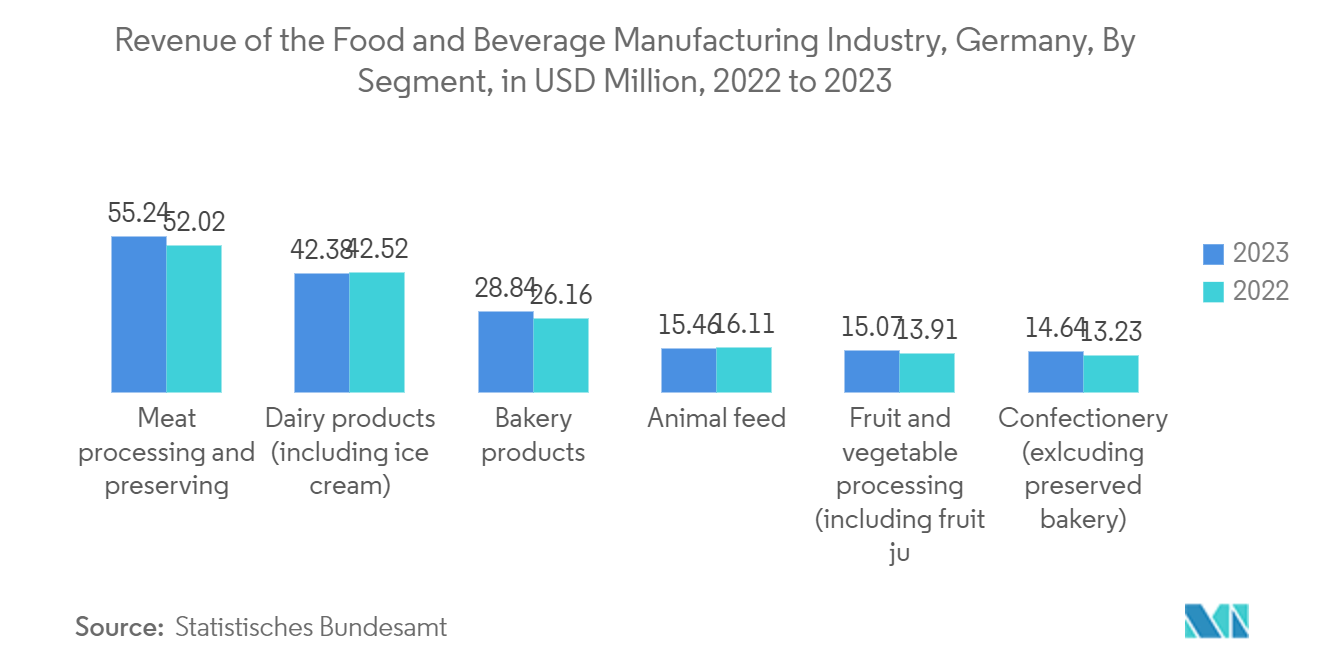
The United Kingdom is Expected to Hold a Significant Market Share
- The UK government stated that by integrating premium produce with advanced technology, the United Kingdom will lead in terms of innovation within the food and beverage industry. This industry represents the largest in the country by revenue, amounting to GBP 104.4 billion (USD 136.5 billion), surpassing the combined value of the automotive and aerospace industries. The United Kingdom offers numerous prospects for exporters, investors, and international purchasers, showcasing essential strengths in the food industry. These substantial market capabilities are expected to stimulate demand within the packaging market.
- The United Kingdom has positioned itself as a leader in innovation, merging high-quality products with technological advancements to meet consumer demands. According to gov.uk, in 2023, 58% of the domestic food consumed in the United Kingdom originated in the country. The rise in popularity of vegetarian and vegan diets represents a significant opportunity for the food industry, prompting manufacturers to develop plant-based and alternative protein sources. The UK government unveiled its Research and Development Roadmap, which aims to boost public investment in research and development to GBP 22 billion (USD 28.99) annually by FY 2024-25. These initiatives are anticipated to boost market growth for diverse packaging technologies.
- The market is witnessing a growing demand for sustainable and environmentally friendly packaging solutions, with funding opportunities available in the United Kingdom to support the development of such products. The government's Smarter Innovation Programme promotes innovations aimed at enhancing manufacturing sustainability by minimizing material waste and energy usage. For example, companies in Greater Manchester are well-positioned to assist the Waste and Resources Action Programme (WRAP) in achieving the goal of making all plastic packaging recyclable, reusable, or compostable by 2025. These advancements in sustainable packaging technologies are anticipated to significantly enhance the market's potential.
- In July 2023, five innovative projects were unveiled aimed at significantly enhancing the sustainability of plastics. With a funding allocation of GBP 6 million (USD 7.87 million), these initiatives seek to mitigate the substantial environmental harm caused by plastics while also extending their usability and increasing their economic value. These multidisciplinary projects, spearheaded by UK universities, will focus on improving the recyclability of multilayer food packaging over a three-year period.
- Several companies are investing significantly in sustainable packaging solutions in the country, which is one of the factors helping the market gain traction. For instance, in November 2023, Nestlé UK and Ireland announced that they would commit GBP 7 million (USD 9.18 million) to the Impact Recycling facility located in Durham. This state-of-the-art plant is dedicated to tackling the challenge of hard-to-recycle flexible plastics and utilizes the Baffled Oscillation Separation System (BOSS) to effectively sort plastics according to their density. Furthermore, this investment contributes to the circular economy by establishing strategic collection points for packaging materials such as KitKat wrappers and Purina pet food pouches.
- Furthermore, in July 2023, BioPak UK, a provider of plant-based compostable packaging solutions, introduced a new range of eco-friendly food packaging. The sandwich wedges and wrap wedges are constructed from responsibly sourced paperboard certified by the Forest Stewardship Council (FSC), complemented by a waterproof lining and window made from Ingeo bioplastic. The company stated that its takeaway sandwich boxes are suitable for industrial composting and meet EN13432 European compostability standards.
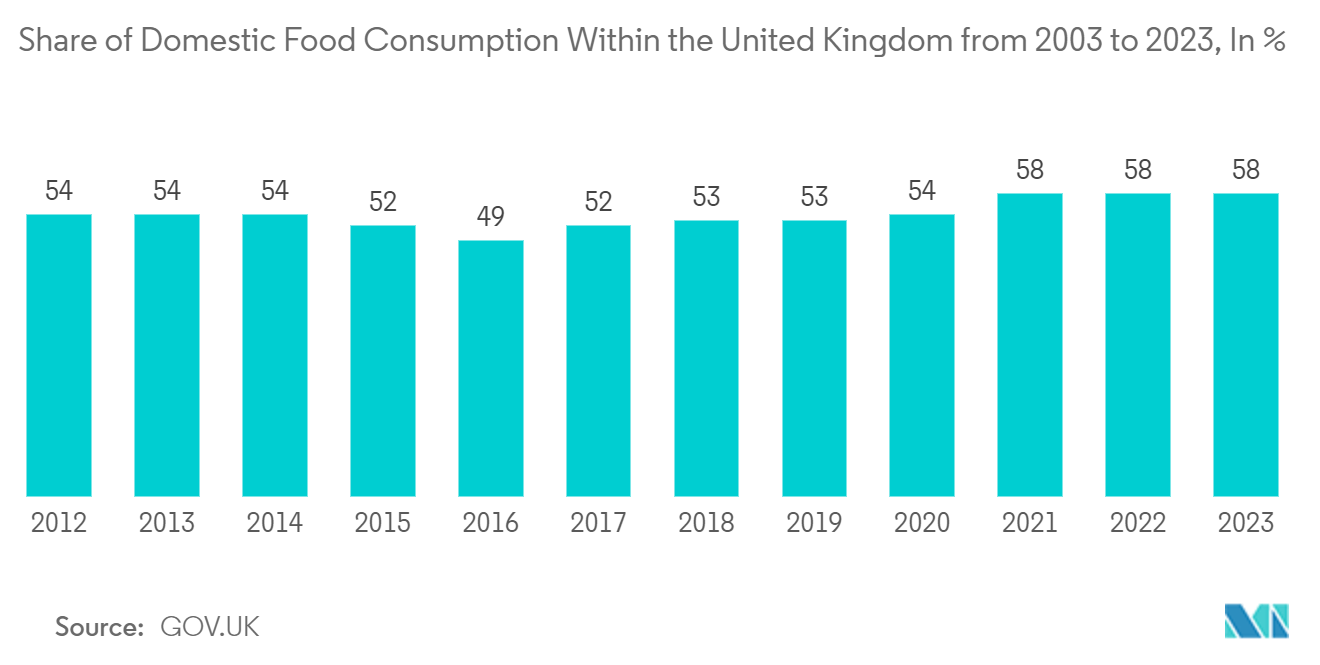
Europe Food Packaging Industry Overview
The food packaging market is highly fragmented owing to the presence of a large number of players, accounting for a significant share. Leading players operating in the market are adopting acquisitions, mergers, technological advancements, expansion, and ground-breaking marketing tactics to strengthen their positions. Some of the major players operating in the market are KM Packaging Services Ltd., ProAmpac, Oerlemans Packaging Group, Greiner Packaging GmbH, and Coexpan S.A.
Europe Food Packaging Market Leaders
-
KM Packaging Services Ltd.
-
ProAmpac
-
Oerlemans Packaging Group
-
Greiner Packaging GmbH
-
Coexpan S.A.
- *Disclaimer: Major Players sorted in no particular order
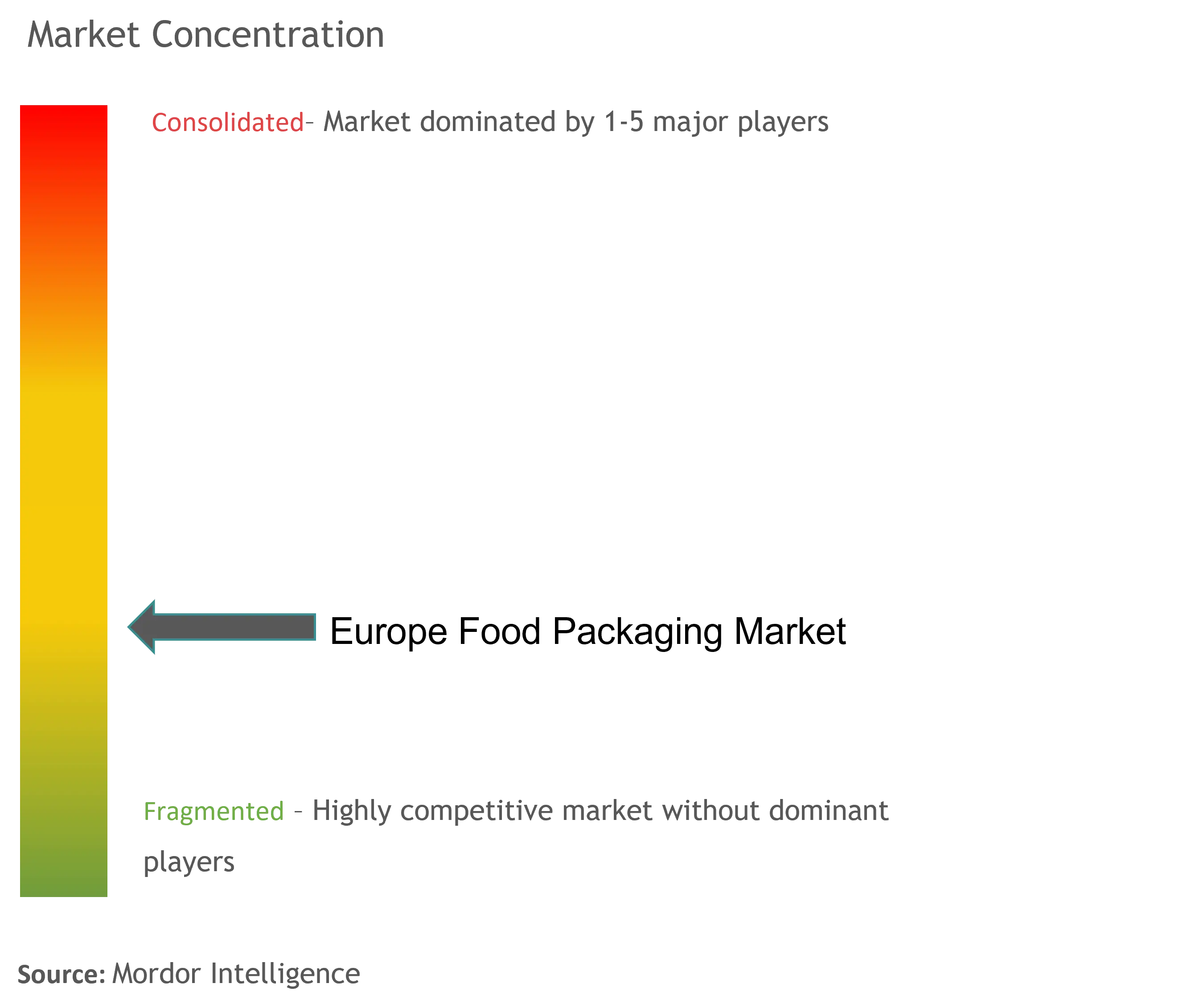
Europe Food Packaging Market News
- June 2024: The supermarket chain Aldi UK made a notable advancement in its sustainability initiatives by integrating recycled plastic into the packaging of its own-brand crisps. This initiative, a first among UK supermarkets, will ensure that a minimum of 35% recycled material is utilized in the packaging of its Specially Selected Hand Cooked range. The products featuring this new packaging are available in stores nationwide.
- April 2024: Klöckner Pentaplast (kp) introduced what it asserted to be the first food packaging tray made entirely from 100% recycled PET (rPET) sourced exclusively from trays. This new kp tray was promoted as the first to consist solely of recycled tray material. The development represents a significant advancement in the packaging market, showcasing the potential that can be realized through the appropriate integration of expertise and technology.
- January 2024: Comax announced its distribution of a ground-breaking range of disappearing food packaging. This innovative concept, developed by the forward-thinking team at Notpla, represents a leading sustainable initiative in the market. Recognizing that a significant portion of plastic pollution originates from packaging, Notpla devised a direct approach to address this issue by creating next-generation packaging solutions. The effectiveness of Notpla’s packaging has been validated by over 3.5 million consumers, demonstrating its strength and dependability comparable to traditional food packaging.
- September 2023: Mondi, a global provider of sustainable packaging and paper solutions, introduced paper-packaged dry rice to the UK market for the first time through a partnership with the renowned rice supplier Veetee. The two organizations worked in close collaboration throughout the entire development process, ensuring that the packaging's barrier properties were appropriate for the product. This was essential to protect the rice from moisture and to guarantee an extended shelf life.
Europe Food Packaging Industry Segmentation
Food packaging refers to materials that enclose, protect, and preserve food products during transportation, storage, and sale. It serves various functions, including maintaining the freshness and quality of the food, expanding shelf life, preventing contamination, and providing important information such as mutational content and expiration dates.
The scope of the study focuses on the market analysis of food packaging in Europe, and market sizing encompasses food packaging product consumption across end-user industries. The study also tracks the key market parameters, underlying growth influencers, and revenue accrued from the market. The scope of the report encompasses market sizing and forecast for segmentation by material (plastic, paper & paperboard, metal, glass), product type (bottles & containers, cartons & pouches, cans, films & wraps, caps & closures), end-user type (fruits & vegetables, meat & poultry, dairy products, bakery & confectionary), and country. The market sizes and forecasts are provided in value (USD) for all the above segments.
| By Material Type | Plastic |
| Paper & Paperboard | |
| Metal | |
| Glass | |
| By Product Type | Bottles & Containers |
| Cartons & Pouches | |
| Cans | |
| Films & Wraps | |
| Other Product Types | |
| By End-user Type | Fruits & Vegetables |
| Meat & Poultry | |
| Dairy Products | |
| Bakery & Confectionary | |
| Other End-users (Sea Food, Convenience food,Snacks and Side Dishes) | |
| By Geography | United Kingdom |
| Germany | |
| France | |
| Spain |
Europe Food Packaging Market Research Faqs
How big is the Europe Food Packaging Market?
The Europe Food Packaging Market size is expected to reach USD 75.24 billion in 2025 and grow at a CAGR of 4.5% to reach USD 93.76 billion by 2030.
What is the current Europe Food Packaging Market size?
In 2025, the Europe Food Packaging Market size is expected to reach USD 75.24 billion.
Who are the key players in Europe Food Packaging Market?
KM Packaging Services Ltd., ProAmpac, Oerlemans Packaging Group, Greiner Packaging GmbH and Coexpan S.A. are the major companies operating in the Europe Food Packaging Market.
What years does this Europe Food Packaging Market cover, and what was the market size in 2024?
In 2024, the Europe Food Packaging Market size was estimated at USD 71.85 billion. The report covers the Europe Food Packaging Market historical market size for years: 2019, 2020, 2021, 2022, 2023 and 2024. The report also forecasts the Europe Food Packaging Market size for years: 2025, 2026, 2027, 2028, 2029 and 2030.
Our Best Selling Reports
Europe Food Packaging Industry Report
Statistics for the 2025 Europe Food Packaging market share, size and revenue growth rate, created by Mordor Intelligence™ Industry Reports. Europe Food Packaging analysis includes a market forecast outlook for 2025 to 2030 and historical overview. Get a sample of this industry analysis as a free report PDF download.




